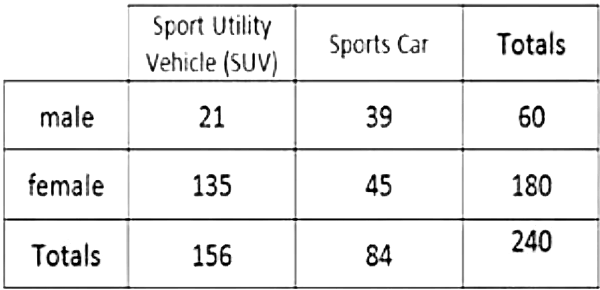Grade 9 Exam > Grade 9 Notes > AP Statistics > Chapter Notes: Expected Counts in Two Way Tables
Expected Counts in Two Way Tables Chapter Notes | AP Statistics - Grade 9 PDF Download
Tests from Two-Way Tables
Another form of data that we can use χ² tests for involves data from a two-way table (like the one pictured below).

When performing a χ² test from a two-way table, there are two different tests we may have to perform, and choosing which one can be tricky.
Test for Homogeneity
A chi-squared test for homogeneity is used to compare the distribution of a categorical variable between two or more independent groups or populations. It tests the null hypothesis that the proportions of the categories are the same in all the groups. In other words, we'll use the chi-squared test for homogeneity when we're comparing two different populations to see if they have different amounts for a given categorical variable.
Test for Independence
A chi-squared test for independence is used to examine the relationship between two categorical variables in a single population. It tests the null hypothesis that the two variables are independent, meaning that the presence or absence of one variable does not affect the probability of the other variable. In other words, we'll use this test when we're comparing within one population to see if two categorical variables are associated.
Expected Counts
Regardless of which test we are doing, we will be comparing two multi-row/column matrices rather than just two rows or columns. This means we have to calculate the expected counts matrix based on our observed counts table. This will be done by doing the following for each cell:

Where n = table total.
Example
In the first cell of the two-way table above on SUV and sports car ownership in regard to male or female, we would take the total male (60) and the total SUV (156), multiply those to get 9360. Then we would divide that total by our table total (240) and get 39. We would complete this process for all cells to create our expected count table.
Our final expected counts answer would be:

Applications
In the next sections, we will talk about setting up the two types of χ² tests regarding a two-way table and how we will use these observed and expected counts to determine if we have an association or homogeneity between our two variables/populations. Stay tuned 'til then!
Question for Chapter Notes: Expected Counts in Two Way TablesTry yourself: What does a chi-squared test for homogeneity compare?View Solution
Key Terms to Review
- Chi-Squared Test for Homogeneity: A statistical method used to determine if two or more populations have the same distribution for a categorical variable.
- Chi-Squared Test for Independence: A statistical method used to determine whether there is a significant association between two categorical variables.
- Expected Counts: The predicted frequencies of occurrences in a contingency table under the assumption of independence or homogeneity.
- Proportions: Represent a part of a whole, typically expressed as a fraction or percentage, crucial for comparing different groups.
- Test for Independence: A method used to determine whether there is a significant association between two categorical variables.
- χ² tests: Statistical methods used to determine whether there is a significant association between categorical variables.
The document Expected Counts in Two Way Tables Chapter Notes | AP Statistics - Grade 9 is a part of the Grade 9 Course AP Statistics.
All you need of Grade 9 at this link: Grade 9
|
12 videos|106 docs|12 tests
|
FAQs on Expected Counts in Two Way Tables Chapter Notes - AP Statistics - Grade 9
| 1. What are expected counts in a two-way table? |  |
Ans.Expected counts are the theoretical frequencies that we would expect to see in each cell of a two-way table if there were no association between the two categorical variables. They are calculated based on the marginal totals of the rows and columns.
| 2. How do you calculate expected counts in a two-way table? |  |
Ans.To calculate expected counts, you use the formula: (Row total * Column total) / Grand total. This gives you the expected frequency for each cell in the table.
| 3. Why are expected counts important in statistical analysis? |  |
Ans.Expected counts are important because they are used to determine whether there is a significant association between the two categorical variables. They help in conducting chi-square tests, which assess how far the observed counts deviate from the expected counts.
| 4. What is the minimum expected count requirement for a chi-square test? |  |
Ans.The general rule is that each expected count should be 5 or more to ensure the validity of the chi-square test results. If any expected count is less than 5, it may lead to inaccurate conclusions.
| 5. How can I interpret the results of a chi-square test using expected counts? |  |
Ans.When you interpret the results of a chi-square test, you compare the chi-square statistic to a critical value from the chi-square distribution. If the observed counts significantly deviate from the expected counts, it indicates a potential association between the variables being analyzed.
Related Searches















